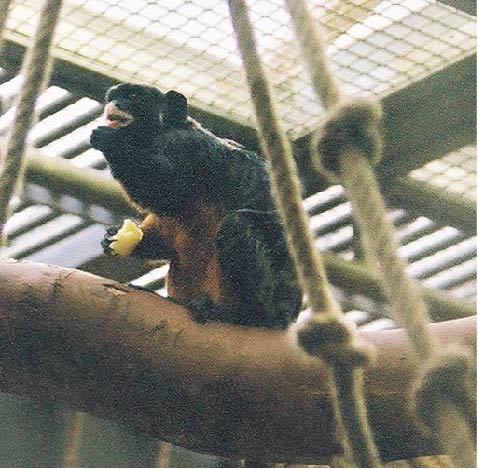Red-bellied Tamarin (Saguinus labiatus)

MORPHOLOGY:
The red-bellied tamarin has nonopposable thumbs and the nails of the digits are claw-like except for the first digit on each toe. Unlike the marmosets, this species, like all tamarins, has canines that are larger than the incisors, and their teeth morphology does not allow them to gnaw into the bark for gum (exudates) like the marmosets (Fleagle, 1988). The most notable coloration on this species is the white hairs that covers the area around the lips. The mean adult body weight for this species is 491 grams (Yoneda, 1981).
RANGE:
The red-bellied tamarin is found in Western Brazil, Northern Bolivia, and in Eastern Peru. This species is found in the higher forest levels, in the middle canopy (Fleagle, 1988).
ECOLOGY:
The red-bellied tamarin forages for a number of food items including: insects, ripe fruits, gum (exudates), and nectar (Kinzey, 1997). They can only forage upon exudates (gum) that is already coming out of the tree by other means (Kinzey, 1997). The red-bellied tamarin forages on insects in the lower and middle levels of the forest canopy on leaves and branches (Garber, 1993). The average group size for the red-bellied tamarins is about 2-4 individuals (Fleagle, 1988). This is an arboreal species.
LOCOMOTION:
This diurnal species walks or runs quadrupedally through the forest, and is capable of leaping between branches (Snowdon and Soini, 1988).
SOCIAL BEHAVIOR:
The red-bellied tamarin has a multimale-multifemale social system (Kinzey, 1997). The groups consist of unrelated adults, and the main mating system is polyandry, with monogamy and polygyny being reported (Kinzey, 1997). Buchanan-Smith and Jordan (1992) found that pair mates of red-bellied tamarins do not form strong pair bonds, and that a pair relationship is maintained through same-sex individual aggression. The offspring are cared for by all adult group members, which includes the males (Kinzey, 1997). The red-bellied tamarin forms mixed-species associations with Saguinus fuscicollis (Yoneda, 1981). These mixed-species associations may serve to assist in protecting from predators (Kinzey and Cunningham, 1994). Hardie and Buchanan-Smith (1997) found that mixed-species associations of red-bellied tamarins and Saguinus fuscicollis benefited from the mixed-species associations from having an overall greater amount of group vigilance (time watching predators), and a lower amount of individual vigilance compared to those groups with only single-species. The red-bellied tamarin has been observed, with Saguinus fuscicollis, to mob a tayra, Eira barbara, together (Buchanan-Smith, 1990).
VOCAL COMMUNICATION:
contact call: This call by the red-bellied tamarin is used to keep track of the whereabouts of other members of the group (Caine and Stevens, 1990).
OLFACTORY COMMUNICATION:
circumanal marking: This is when a red-bellied tamarin rubs the substrate with the circumanal areas in a sitting position; this is the most frequent marking behavior for this species (Epple et al., 1993).
VISUAL COMMUNICATION:
open-mouth lunge: This is defined as, "the head and mouth are thrust forward toward another individual, while the mouth is open sufficiently to reveal the lower canines" (Buchanan-Smith and Jordan, 1992).
TACTILE COMMUNICATION:
REPRODUCTION:
The red-bellied tamarin gives birth to twins like most callitrichids (Kinzey, 1997).
REFERENCES:
Buchanan-Smith, H.M. 1990. Polyspecific Association of Two Tamarin Species, Saguinus labiatus and Saguinus fuscicollis, in Bolivia. American Journal of Primatology. Vol. 22, 205-214.
Buchanan-Smith, H.M. and Jordan, T.R. 1992. An Experimental Investigation of the Pair Bond in the Callitrichid Monkey, Saguinus labiatus. International Journal of Primatology. Vol. 13, 51-72.
Burton, F. 1995. The Multimedia Guide to the Non-human Primates. Prentice-Hall Canada Inc.
Caine, N.G. and Stevens, C. 1990. Evidence for a ‘Montotring’ Call in Captive Red-bellied Tamarins. American Journal of Primatology. Vol. 22, 251-262.
Epple, G., Belcher, A.M., Kuderling, I., Zeller, U., Scolnick, L., Greenfield, K.L., Smith III, A.B. 1993. Making Sense Out of Scents: Species Differences in Scent Glands, Scent-marking Behaviour, and Scent-mark Composition in the Callitrichdae. in Marmosets and Tamarins: Systematics, Behaviour, and Ecology. ed. Anthony B. Rylands, Oxford University Press.
Fleagle, J. G. 1988. Primate Adaptation and Evolution. Academic Press.
Garber, P.A. 1993. Feeding, Ecology, and Behaviour of the Genus Saguinus. in Marmosets and Tamarins: Systematics, Behaviour, and Ecology. ed Anthony B. Rylands. Oxford University Press.
Hardie, S.M. and Buchanan-Smith, H.M. 1997. Vigilance in Single- and Mixed-species Groups of Tamarins (Saguinus labiatus and Saguinus fuscicollis). International Journal of Primatology. Vol. 18, 217-234.
Kinzey, W.G. 1997. Saguinus. in New World Primates: Ecology, Evolution, and Behavior. ed. Warren G. Kinzey, Aldine de Gruyter, New York.
Kinzey, W.G. and Cunningham, E.P. 1994. Variability in Platyrrhine Social Organization. American Journal of Primatology. Vol. 34, 185-198.
Snowdon, C.T. and Soini, P. 1988. The Tamarins, Genus Saguinus. in Ecology and Behavior of Neotropical Primates, Vol. 2 PP. 223-298. Eds, R.A. Mittermeier, A.B. Rylands, A.F. Coimbra-Filho, and G.A.B. da Fonseca. Washington, DC: World Wildlife Fund.
Yoneda, M. 1981. Ecological Studies of Saguinus fuscicollis and S. labiatus with Reference to Habitat Segregation and Height Preference. Kyoto University Overseas Research Reports. Vol.2, 43-50.
Last Updated: May 5, 2004.
[The Primata] [Primate Fact Sheets] [Family Callitrichidae] [Saguinus Links]

